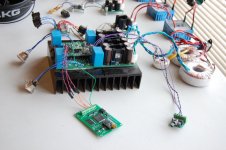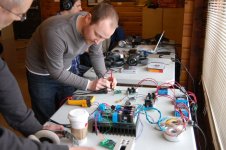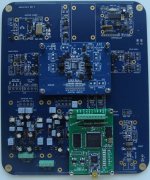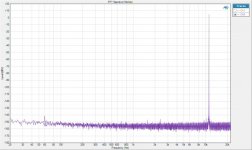Thank you very much for your quick response. Does this mean that if I were to be able to find a ASIO sound card, with an audio input jack, I would be able to use the exaU2I directly in the software?
Also, would there be any disadvantages by using the VAC method?
In my case it didn't work with EMU0404. Audiolense insists on using the same ASIO device for Input and output.
Theoretically if you use the proper sampling rates, you will be able to avoid re-sampling. If the Windows volume control is set to 0dB, VAC is supposed to be bit perfect. The only remaining compromising factor is the Windows mixer.
It is worth it to try it. Please tell us about your results.
Thank you for testing it out so quickly!
I don't know if this is the place to ask, but like I said before, I plan on using the convolver in Jriver. I would like to use the native exaU2I asio drivers in Jriver, but if I make the convolver file with VAC, would I also be forced to use VAC in Jriver as an output device?
I am still researching this, so I may find an answer somewhere. Still new to Convolver....
Btw, I have your exaU2I setup with the Buffalo 3 dac in my car(Perhaps worlds first?). It sounds truly amazing!
Unfortunately, it's still a passive XO setup, but I plan on making it a 3-way active XO setup, with "room correction" with audiolense...
I will let everyone know the result...
I don't know if this is the place to ask, but like I said before, I plan on using the convolver in Jriver. I would like to use the native exaU2I asio drivers in Jriver, but if I make the convolver file with VAC, would I also be forced to use VAC in Jriver as an output device?
I am still researching this, so I may find an answer somewhere. Still new to Convolver....
Btw, I have your exaU2I setup with the Buffalo 3 dac in my car(Perhaps worlds first?). It sounds truly amazing!
Unfortunately, it's still a passive XO setup, but I plan on making it a 3-way active XO setup, with "room correction" with audiolense...
I will let everyone know the result...
Thank you for testing it out so quickly!
I don't know if this is the place to ask, but like I said before, I plan on using the convolver in Jriver. I would like to use the native exaU2I asio drivers in Jriver, but if I make the convolver file with VAC, would I also be forced to use VAC in Jriver as an output device?
I am still researching this, so I may find an answer somewhere. Still new to Convolver....
Btw, I have your exaU2I setup with the Buffalo 3 dac in my car(Perhaps worlds first?). It sounds truly amazing!
Unfortunately, it's still a passive XO setup, but I plan on making it a 3-way active XO setup, with "room correction" with audiolense...
I will let everyone know the result...
You need to test the filters in JRiver with both ASIO and VAC. Let's hope that it will sound identical. I prefer using ASIO because of the automatic sampling rate switching. and the guaranteed 32-bit-perfect processing.
Agreed! PLEASE continue the development of mk II
Thank you for your support! I just couldn't see the demand for exaU2I MKii, so I committed the company resources to another project. Part of the issue is that exaU2I works quite well - check the measurements. It there is enough action, I can come back to this project. Perhaps a pre-order system or a "group buy" is the way to go.
-Best,
exa065
Thank you for your support! I just couldn't see the demand for exaU2I MKii, so I committed the company resources to another project. Part of the issue is that exaU2I works quite well - check the measurements. It there is enough action, I can come back to this project. Perhaps a pre-order system or a "group buy" is the way to go.
-Best,
exa065
Hi exa065,
Problem is that most people don't need the 8 channels and that makes it quite expensive for just 2 channels use when there are many good XMOS solutions already available to purchase.
I don't know about the others but I would certainly commit to a pre-buy or a GB if you retained all features but remove the 6 other channels. Only need a stereo setup. Price would need to be competitive with other solutions as well. Of course still see what the DIYaudio community would want in a MKII if doing a GB... 😉
Best regards
Do
During the past few weeks I took some measurements of exaU2I connected to our first DAC prototype, code-named the BlackDAC. Here they are.
Very nice. :-D
So is this the e18 DAC, or something else? :con fused:
Very nice. :-D
So is this the e18 DAC, or something else? :con fused:
Thanks! As I've mentioned, the measurements are taken with our first DAC prototype, code-named the BlackDAC. The BlackDac was produced before the exaU2I and it was never released. We have several units and we use them for experiments.
e18 has a different built-in USB to I2S interface and cannot be connected to the exaU2I.
Last edited:
exaU2I - NTD1
Earlier this month I attended the DIY Ottawa Winter Fest. It was a real pleasure to meet this great group of seasoned DIYers to talk about, and listen to their creations. I am building two of OPC's Wire amplifiers and I had the opportunity to meet him and to see his work.
The pictures: exaU2I connected to OPC's NTD1.
Earlier this month I attended the DIY Ottawa Winter Fest. It was a real pleasure to meet this great group of seasoned DIYers to talk about, and listen to their creations. I am building two of OPC's Wire amplifiers and I had the opportunity to meet him and to see his work.
The pictures: exaU2I connected to OPC's NTD1.
Attachments
Earlier this month I attended the DIY Ottawa Winter Fest. It was a real pleasure to meet this great group of seasoned DIYers to talk about, and listen to their creations. I am building two of OPC's Wire amplifiers and I had the opportunity to meet him and to see his work.
The pictures: exaU2I connected to OPC's NTD1.
Looks great! I am still waiting to have my NTD1 finished as it is a very complicated build (including an EXAU2I 😉 ), did you have a chance to hear how it sounds?
Please give us the ExaU2I MkII, please...
Hi George,
I was able to get past my error earlier on OSX, it was just that my USB serial cable driver was interfering so I deleted its kext, rebooted and was able to connect the EXA. All is good now!
thanks for your help,
Will
I was able to get past my error earlier on OSX, it was just that my USB serial cable driver was interfering so I deleted its kext, rebooted and was able to connect the EXA. All is good now!
thanks for your help,
Will
...I am still waiting to have my NTD1 finished as it is a very complicated build (including an EXAU2I 😉 ), did you have a chance to hear how it sounds?
It sounded great! Very natural, clean and detailed, with perfect base, no noise, no distortion, nothing to give you the slightest hint for imperfection.
Just an insane unlikely idea:
Can you replace the clock on the exaU2i board?
- with another clock, with same MHz? (like crystek 950 cchd)
- with another frequency - like 100MHz ??
Can you replace the clock on the exaU2i board?
- with another clock, with same MHz? (like crystek 950 cchd)
- with another frequency - like 100MHz ??
exaU2I Clocks Upgrade
-Best,
exa065
You can replace the clocks, but you need to match the frequencies. Actually the next batch of exaU2I devices will come with upgraded custom 1 ps clocks.Just an insane unlikely idea:
Can you replace the clock on the exaU2i board?
- with another clock, with same MHz? (like crystek 950 cchd)
- with another frequency - like 100MHz ??
-Best,
exa065
XMOS causes 2.5 ns Jitter?
Here is an interesting post by JarekC:
http://www.diyaudio.com/forums/digi...pdif-converter-24bit-96khz-2.html#post2921904
It appears that according to Larry, an XMOS employee:
" any external clock is resampled to 400MHz
If you tie I2S signals BCLK LRCLK and DATA to a low-jitter external
clock on the XMOS device, this will introduce a jitter in the order of
one to two 2.5ns (400MHz) cycles"
XMOS causes 2.5 ns JITTER? I will investigate this further.
Here is an interesting post by JarekC:
http://www.diyaudio.com/forums/digi...pdif-converter-24bit-96khz-2.html#post2921904
It appears that according to Larry, an XMOS employee:
" any external clock is resampled to 400MHz
If you tie I2S signals BCLK LRCLK and DATA to a low-jitter external
clock on the XMOS device, this will introduce a jitter in the order of
one to two 2.5ns (400MHz) cycles"
XMOS causes 2.5 ns JITTER? I will investigate this further.
More DXD 352.8kHz 5.1 Test Tracks
2L has released more DXD 352.8kHz 5.1 test tracks. Check out their HiRes Download page at High Resolution Music DOWNLOAD services .:. FLAC in free TEST BENCH.
2L has released more DXD 352.8kHz 5.1 test tracks. Check out their HiRes Download page at High Resolution Music DOWNLOAD services .:. FLAC in free TEST BENCH.
XMOS causes 2.5 ns JITTER?
Isn't it 4 times better than 10 ns that ES9018S chip has in its asynchronous resampling processing when you use 100 MHz oscillator for asynchronous MCLK?
Will the dsd playback work for 5.1 or only 4 channels??
DSD will work only on four channels. As you know DSD works by using a workaround. It is not a standard feature of exaU2I.
108 ps jitter vs. 2500 ps jitter
Isn't it 23 time worse than the 108 ps worst-case scenario jitter of exaU2I? Actually our estimate for exaU2I is 40ps.
2.5 ns is horrible 🙂
Isn't it 4 times better than 10 ns that ES9018S chip has in its asynchronous resampling processing when you use 100 MHz oscillator for asynchronous MCLK?
Isn't it 23 time worse than the 108 ps worst-case scenario jitter of exaU2I? Actually our estimate for exaU2I is 40ps.
2.5 ns is horrible 🙂
Attachments
- Home
- More Vendors...
- exaDevices
- exaU2I - Multi-Channel Asynchronous USB to I2S Interface



